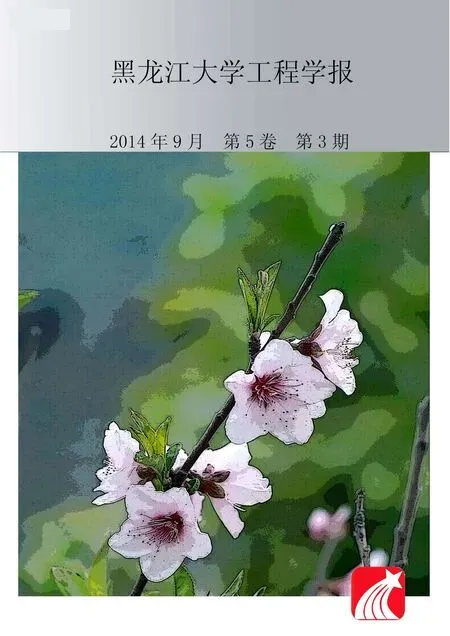气候变化背景下俄罗斯寒区交通基础设施功能存在的问题
2014-03-19Shesternev
Shesternev D.M.
(俄罗斯科学院西伯利亚分院麦尔尼科夫冻土研究所,雅库茨克677010,俄罗斯)
0 Introduction
Well-functioning transportation infrastructure is a guarantee of sustainable economic and social development of any country.This applies particularly to China,Russia and the United States where the length of highways reaches many thousands of kilometers.These countries have widespread permafrost within their territories.For example,in Russia,permafrost occupies 70%of the country.
Systemic transportation development in the Russian permafrost regions has begun in the late 19th cen-tury and continues to the present moment.Tens of thousands of kilometers of railways and roads,oil and gas pipelines,and power lines have been commissioned and operated over this period.Main transportation routes construction and operation technologies have changed significantly during thisperiod,justas changed technical means providing them.Natural environments in which they operated also underwent changes.Increase in the mean annual air temperature emerging in the late 19th-early 20th century stabilized in the mid-twentieth century on the relatively low values,yet not threatening permafrost.From then on air temperatures,depending on the regional characteristics,reached values which are alarming for its existence.This applies especially to the southernmost permafrost regions.Nowadays mean annual air temperatures here only occasionally reach-2℃,while it was-3.0℃ or lower before.In some years such values were extreme for the permafrost.For example,in 2007,in the city of Chita the mean annual air temperature was 0.5°C for the first time for more than a hundred years of observations.A similar trend in air temperatures was typical for almost all the cold regions of Russia in the late 20th-early 21st century.Undoubtedly,this has led to significant changes in temperature,thickness,structure,distribution and properties of permafrost under natural conditions of its existence.These changes had a negative impact on the thermal and mechanical interaction of permafrost with linear structures being constructed and operating[1].
Climatic parameters prior to the period of their intense change,being essentially quasi-equilibrium types of natural-technical systems(NTS),are currently out of this state and constitute non-equilibrium systems.Efficiency of the management of such systems is inconspicuous.This fact is determined by the weak predictability of changes of the upper boundary conditions of the NTS existence;permanent changes in the composition,structure and properties of NTS geotechnical subsystem depending on fluctuations of climatic rhythms parameters.
Linear structures are of great length but they occupy a small area.Therefore,the operation of the transportation NTS influences a large number of different factors.This requires the use of an individual approach to examination,construction and management of the NTS.However,typical projects developed without regard to specific geocryological environment and to effects of climatic rhythms at the kinetics are generally used in the design of transportation linear structures.Today,the issues related to the development and use of innovative technologies and materials for the implementation of management in a given direction of interaction of separate elements of transportation linear systems,their design featuresproviding specified operating modes,remain poorly studied.
It should be noted,however,that in recent decades fundamental and applied sciences of the natural cycle have paid relatively little attention to the improvement of efficiency of the use of transportation linear NTS in the cold regions of Russia,mostly solving the problems associated with the elimination of the consequences,and not searching for causes of their occurrence.
Given the above,as well as high rates of construction and reconstruction of linear structures in cold regions planned by the Russian government,the resolution of the above problems is urgent and has fundamental and practical importance.
1 The role of transportation infrastructure in the development of the Far Eastern Federal District (FEFD)
To analyze the economic potential of the territory it is absolutely necessary to know its area,resources,population density and existing infrastructure,including prospects for its urbanization.In this aspect,the eastern region of Russia in concentrated tree view is represented by the Far Eastern Federal District (FEFD).It consists of 9 subjects of the Russian Federation:Republic of Sakha(Yakutia);Primorsk,Khabarovsk and Kamchatka Territory;Magadan,Sakhalin,Amur regions;Chukotka Autonomous Okrug, and the Jewish Autonomous Region.Almost the entire territory of the FEFD is notable for the development of permafrost from continuous to sporadic permafrost and deep seasonal freezing.
FEFD territory is little more than 7 millions square kilometers(about 36%of Russian territory)inhabited by only 4.5% of its population,and the population density here is little more than 1 people per km2.68 cities with a population more than 75% of the total FEFD population are built within its borders.
In recent years,the significance of the FEFD for the Russian economy has grown substantially due to the rapid economic development in the countries of the Pacific Region-China,Japan,South Korea,and North Korea.A very important role in this regard is attributed to the resources of the region[2].Moreover,in addition to traditional land,forest,agricultural,biological,and other kinds of resources that do not need to be enumerated,in recent decades the beginning of the development of South-West oil and gas region of Yakutia where stocks of raw materials overcome those in Western Siberia has been particularly important.In addition,the economic growth of the region is associated with oil and gas recovery in the shelf area of the Sea of Okhotsk and in Sakhalin,inferred resources of which constitute about 40%of all proven reserves of Russia.However,the specific weight of industrial output there is only about 5%of the industrial output in Russia.More than 50%of this share is attributed to non-ferrous metallurgy,fuel and energy complex.
In terms of international economy,export significantly exceeds import in the FEFD.China,Australia,the USA,Japan,Korea and Mongolia hold key positions in the import of products into the market of the FEFD.We supply the world market with high quality raw materials getting in return finished products-from food to machine building-just like in“stagnant”times,but with greater intensity.
There is no need to go into the causes of economic stagnation of the FEFD.I wish I could write how experts are sent here from the center of Russia,how the economy rises from its knees,how comfort living conditions for its inhabitants are being created at these amazingly beautiful open spaces.Moreover,when I speak about comfort I don’t mean only living quarters,but also presence of the growth prospects for each inhabitant of the region.The possibility of free movement within Russia as well as abroad is also of great importance.At the moment we have a paradoxical situation when it is more difficult to get to the central regions of Russia than in neighboring Asian countries.Undoubtedly,in this case an important role is attributed not only to the cost of transportation services but also to their diversity.In this regard,roads and railways,as well as civil aviation are crucial.Nowadays,air transportation and railway(Trans-Siberian)are of great use.The Amur Highway has been commissioned since 2010.Its operation rate does not stand up to scrutiny in comparison with railway transport.The internal communication between regions is very weak.River transportation plays a great role in summer here.
Several centuries ago Lomonosov M.V.said,‘Russia will grow to Siberia’.The great scientist was not mistaken.It is growing but very slowly.If you look at a map of Russia,it is easy to notice that the intensity of this growth is almost directly proportional to the intensity of its transportation development.After the construction of the East-Siberian Railway and its neighboring roads in the late 19th-middle 20th century the southern areas of the FEFD are the most economically developed in the permafrost region.Subarctic and arctic regions of the FEFD,despite the fact that historically the main mining areas of Russia are located here,are still in operation,mainly due to the freight shipments into the northern areas in advance during the short summer shipping season and due to the winter roads in winter.Rather high cost air transportation also comes to help.As a result,FEFD and the country bear multibillion losses and lose investment attractiveness for the development of natural resources of the FEFD,modernization and construction of industrial enterprises.In this regard,great importance has been attached to the development of roads as the most flexible form of transportation for the past decade.The evidence of this is the paved Amur Highway being in operation since 2010,as well as the Vilyuy,Kolyma and Lena High-ways under construction.
2 Experience of transportation development of the FEFD
The practice of more than two centuries of the development of the cold regions of Russia and the world has shown that permafrost is not so eternal.This is especially noticeable within the southernmost regions of its distribution.The permafrost has completely degraded,or its table(currently)lies at significant depths from the active-layer base in the areas of shallow bedrock,as well as on the river terraces composed of sand and pebble deposits.
In the context of global climate change in the northern regions of our planet,including central Yakutia,changes in air and permafrost temperatures,distribution and thickness of seasonal frost and permafrost,cryogenic structure and ice content of permafrost soils have been observed in recent decades.As a result,structural properties of the permafrost soil that determine the efficiency of operation of engineering structures,including roads,deteriorate.In addition,the area has grown and it has become difficult to predict the kinetics and mechanics of the development of dangerous geocryological processes and features(seasonal frost heave and settlement,perennial frost heave,frost jacking,thermokarst,settlement and icings,etc.) and engineering-geological processes causing paludification,landslides,gullies,etc.We managed to prove the impressive effect of these processes and their complexes in April,2012,during the reconnaissance survey of the M-56 Lena Highway and the section of the M-58 Amur Highway from Skovorodino to Chita.
Starting from Skovorodino station,works were carried out with the participation of the employees of the federal public institution“Interregional Directorate for road construction in the Russian Far East District of the Federal Road Agency”(FKU DSD“Far East”)under the supervision of the head of department Nikolay Zaytsev.On the Trans-Baikal road section-together with the employees of the federal public institution“Administration of Federal Highways in the territory of the Trans-Baikal region under the supervision of chief engineer Andrey Romanov.The main objective of these works formulated by the representatives of the Ministry of Transportation of the Russian Federation was a preliminary inventory of road sections impeding traffic flow,and in some cases being accident clusters.
AM-56 Lena Highway(Yakutsk-Never)is Irkutsk-Yakutsk road modernized in historic times,located on the Aldan Upland.The beginning of its use refers to the mid-XVIII century.Width of the carriageway of the road constitutes 6~8 m,that of canvases-8~13 m,length-1 157 km.The road has 138 bridges and overpasses and more than 900 culverts,road surface is gravel and asphalt in areas near the cities.So far,the road remains to be one of the main highways of vital supplies to Yakutia.The route of the highway lies from the south to the east of Yakutia,crossing the low to mid-height mountains of the Aldan Upland.Sporadic permafrost with a thickness of not more than a few tens of meters is prevalent in southern part of the upland,in the north-continuous permafrost with a thickness ranging between a few hundred meters.The presence of permafrost and development of the geocryological processes impeded and continue to impede the construction and operation of the road.
Since the 1930s,road maintenance services of Lena Highway have been actively fighting with the development of icings.Despite the technological resources increased during this period,icings of different genetic types(from river to ground water icings)are still overcoming human efforts.Also remain problematic hydrothermal seasonal frost heave and settlement caused by ice storage in the base and body of the road embankments during freezing of seasonally thawed soil layer in winter and thawing of this layer in summer[3].Lena Highway sections crossing soil complexes of floodplains and terraces of temporary and permanent streams,almost all can be attributed to the sections within which the permafrost conditions reduce or may reduce the efficiency of the highway operation.According to the results of the reconnaissance surveys carried out on the Lena Highway the total length of such sections is at least 100 km.
The length of the M-58 Amur Highway(Chita-Khabarovsk)is 2 283 km.It runs across the four federal subjects of Russia:Zabaikalye Territory,Amur Region,Jewish Autonomous Region,and Khabarovsk Territory.It is assumed that it must be part of the transcontinental transportation corridor Paris-Berlin-Moscow-Vladivostok.
The reference point of the Amur Highway construction refers to the beginning of Trans-Siberian Railway.The old Moscow Highway became the prototype for the road.In 1956,the project on the construction of the road away from it was developed.Not more than 25%of the projected length of the road was built by 1998.In 2004,the first stage of construction was finished which resulted in the base and macadam surfacing of the road,after completion of the second stage of construction in 2009~2010-asphalt concrete pavement.
The Amur Highway is located in the southernmost permafrost regions of Russia.Here,permafrost is massive and sporadic in distribution.Its thickness does not exceed a few tens of meters,and its temperature varies mainly from 0 to-2 degrees.Seasonal freeze-thaw depths range from 2 to 3 min fine-grained soils and reach 5~6 m in sands and gravels.
The long duration of the construction could not affect the transformation of permafrost conditions of the territory,since technological schemes of construction changed each time,therefore,their interaction with permafrost soils also modified.This fact reflected in its state and its reaction to the interaction with the technical structure that appeared so fast in the thermodynamic field of its existence.
Despite the fact that permafrost conditions in the territory of its location are much simpler than the conditions of the Lena Highway running,permafrost conditions increasingly affect the quality of operation of Chita-Khabarovsk road at the present stage of its existence.For example,on the legs of 794+000 km~1 811+000 km and 90+000 km~794+000 km,local areal types of seasonal settlement and heave have recently led to the formation of about 200 sections where operational characteristics of the linear structures substantially and permanently deteriorate.Moreover,now we can’t say definitely that the cause of this heave and settlement is one or two natural factors or a constructed structure.We can only state the fact that deterioration of the highway operational characteristics is caused by frost heave and settlement of the road bed and subgrade.They are evident in the subgrade embankment,in the destruction of the subgrade and hard surface-mainly in the form of cracks.Strain cracks reach 10~20 cm in width,extending to a depth of 1 m (Fig.1).
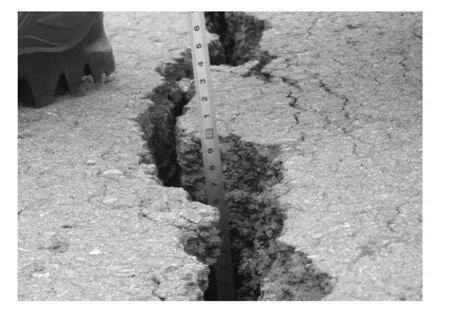
Fig.1 Amur Federal HighwayStrain cracks of asphalt concrete pavement at the section of degradation of permafrost soil of subgrade support
The settlement reached more than 1.5 m for 5 years of operation and continues to evolve even now at the“Chichon”section of the road.Moreover,the development of strains is observed in each of the annual cycles of rock freezing and thawing.The northern embankment slope has been terraced in the development of landslides for this period.As a result,longitudinal cracks have formed on the periphery of asphalt concrete pavement.The sagging reaches 15~20 cm and more per year in the central part(Fig.2).Attempts to find out the cause(s)of its development haven’t been successful till the present time.The reasonableness of existing hypotheses about the impact of the piping and thaw settlement of permafrost soil of the bed is unlikely.As a result,there is a question about a radical reconstruction of the subgrade.
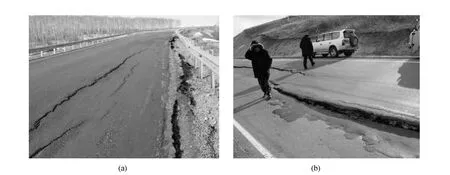
Fig.2 Types of embankment settlement and cracking of the Amur Highway pavement at the intersection of Chichon brook valley
Icings(Fig.3)play a significant role in the reduction of operational characteristics of the Amur, Kolyma,Lena and other highways and roads within the regions of permafrost.
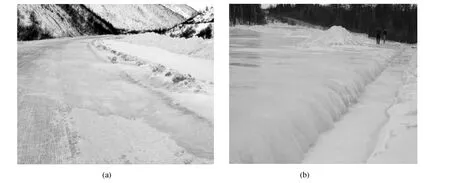
Fig.3 Icings on the Kolyma(a)and Lena(b)Federal Highways,complicating road operation in winter
Control of icings on the roads is usually performed through fairly primitive,though cost effective methods.Generally,these are floodboards preventing the runoff of the icing water.Icings are formed in mid-spring period due to the surface and baseflow waters.The thickness of icings reaches 1~2 meters and more,the area can reach from hundreds to 1 000 square kilometers and more(Fig.4 a,b).
Scientific and methodological support of the research on the Amur Highway performed during the survey by OJSC Irkutskgiprodorniya,and scientific research of the Laboratory of Permafrost Engineering,Melnikov Permafrost Institute,revealed that road surface settlement strains have symmetrical and asymmetrical shape and reach 1.0 m or more.As a rule,they are widespread at the height of the subgrade,the thickness of which does not exceed the standard values of the depth of seasonal soil thawing and freezing.In some cases they develop intensively at the subgrade height of 8~10 m.
The studies performed at the 18 key sections of the Amur Highway showed that the main causes of unacceptable strain of subgrade and asphalt concrete pavement cracking are:
-degradation of permafrost soil of roadbeds characterized by a complex permafrost structure and high ice content;
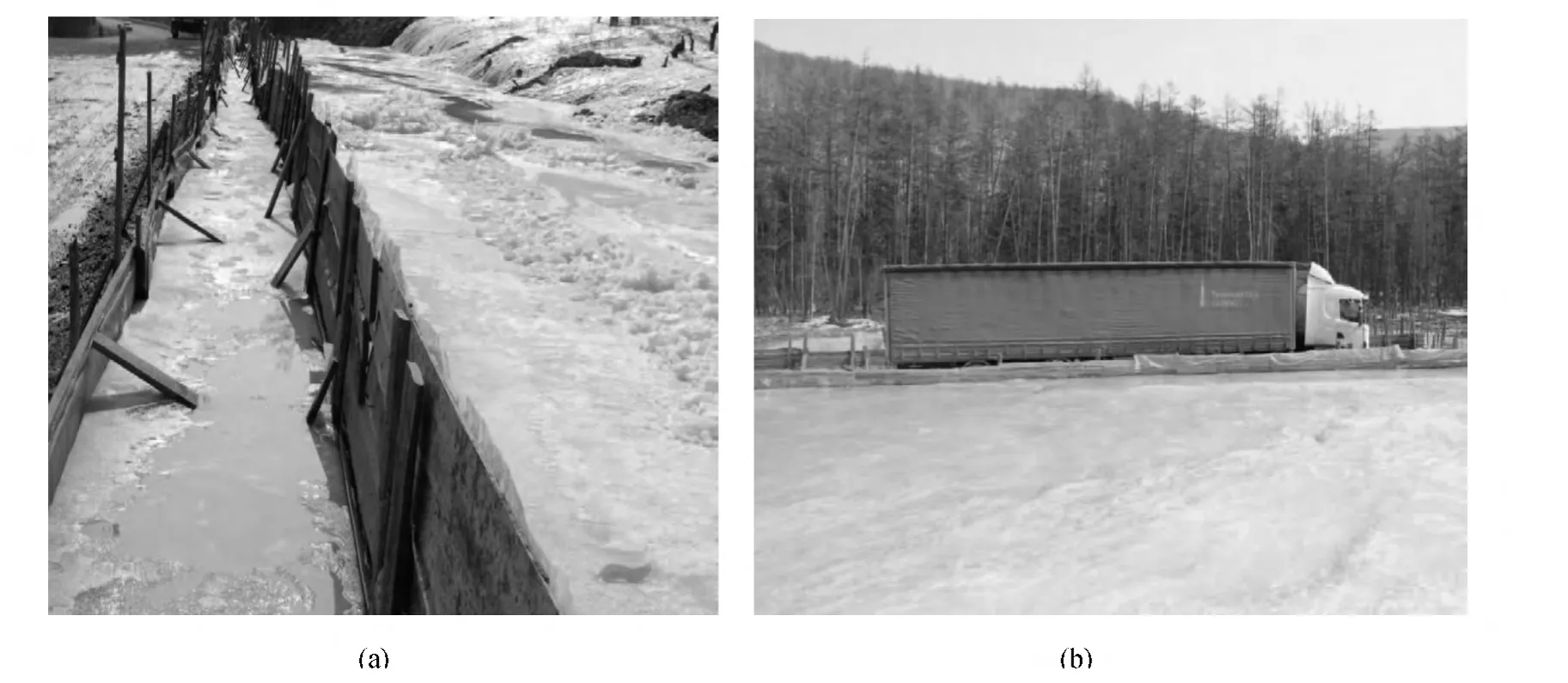
Fig.4 Icings on the Lena Federal Highway 1 076 km(a)and Lena Federal Highway 790 km (b)impeding the operation of roads in winter
-formation of a trough-shaped thaw bulb in the ground bed of the road with its constant water-logging;
-differential thawing of seasonally frozen soil of the subgrade and permafrost upper horizons of the road subsoil;
-cut of the icy soils that contributes to the formation of additional moisture sections of roadbed soil thawing.
The major activities that could prevent the emergence of strains on the Amur Highway,in our opinion,should have been developed and implemented at the time of its construction.But the survey carried out in the area of sporadic permafrost,did not take into account the fact that the length of these islands can be significantly less than the run of the test borings.The fact that under dynamic loads the silty soils will run upon thawing which will cause settlement similar to sagging in its rate of development is not paid attention[4].At this stage it was necessary to pay attention to individual planning of special events for water discharge,but not to the use of its traditional forms.
In Yakutia,rehabilitation and construction of Lena,Vilnyuy,Kolyma and other highways are under way that will provide a permanent link between the industrial and mining centers located in the territory of the FEFD in its arctic and subarctic zones.
Along with the increase in the length of roads,a railway network of local and federal levels is being developed.At present,5 railways are constructed and operated in the permafrost regions:East Siberian,Far Eastern,Trans-Baikal,Sverdlovsk and Northern Railway.All of them are in the subordination of“Russian Railways”OJSC(RZD OJSC).The construction of another railway,located within the Republic of Sakha(Yakutia)Amur-Yakutsk Mainline is completed;its departmental affiliation is not yet established.The construction of railways in the direction of Alaska and Magadan is in prospect.However,even taking into account more than a century of experience in the construction and operation of railways in permafrost,including Amur-Yakutsk Mainline,it is still impossible to fully predict and prevent a negative impact of the geocryological processes on their functional stability.As a rule,the most vulnerable elements of the railway structures include subgrade;permeable embankments of the subgrade;edges of deep cuts;sections of the subgrade with stationary man-made structures,mainly corrugated culverts(Fig.5).
This also should include a group of buildings and structures at the stations in the case of non-uniform thermal load on the ground beds regardless of the chosen principle(with or without saving permafrost)of construction.In all cases the beds of the above struc-tures are sandy-clayey ice-rich soils of thaw susceptibility class III-IV or highly frost-susceptible soils occurring in the zone of active interaction with the elements of structures,paludified areas and ancient karst areas in the process of cryopreservation up to the construction of the structure.Traditional methods are generally used to control the temperature pattern of the subsoil and embankments-the height of the embankment,rock embankment,thermal insulation,etc.
“Proekttransstroy”OJSC,Moscow,on the basis of the fundamental research performed by the Permafrost Institute,projected and together with“Yakutia Railways”OJSC introduced innovative technologies for individual construction on ice-rich soils.These technologies made it possible to preserve permafrost.It should be noted that such comprehensive utilization of innovative technologies for the construction of the railway was carried out in Russia for the first time.The same is with the first large-scale project of geocryological monitoring.It should be noted that initially its organization and conduct was carried out in addition to the technical monitoring of Amur-Yakutsk Mainline construction and operation,i.e.functionally its main task was to monitor possible adverse situations rather than the development of measures to address those situations.Expanding the scope of monitoring tasks allowed performing the inventory of Amur-Yakutsk Mainline sections for potential emergency hazard.There are 12 such“hot”sections,but their total length is 35 km.It should be noted that the elimination of the negative impact of geocryological processes on the subgrade is ensured by carrying out minor repairs and ballasting.Use of ballast stone for these purposes in 2010 has doubled as compared to 2009.In monetary terms,this cost 509.3 thousand rubles in 2009 and 1 253.4 thousand rubles in 2010.In addition to the subgrade,the processes of strains of the deep cut edges are now activated.In the near future this may lead to new section with repairing work areas,increase the costbased potential to maintain operational reliability of A-mur-Yakutsk Mainline[5].
Notable is the role of man-made structures,mainly culverts and permeable embankments,in the development of strains of the railway subgrade.Typically,these processes evolve the maximum in the vicinity of the center line of the corrugated pipes location,and they practically cease(decay)with distance from it at about 40~50 m.Among other things small saucer-shaped thermokarst paludified areas have formed almost everywhere in the piedmont areas in the places of the pipe outlet.These saucer-shaped thermokarst paludified areas increase in their size from year to year.
Similar processes are typical for permeable embankments.And in this case thawing is observed almost across the entire width of the lane,especially in places where the vegetative cover was removed during construction.
Processes of freezing and thawing are accompanied by differential heave and settlement of the subgrade and development of geocryological processes(e.g.,icings,frost cracking).Lowering of the top of permafrost is accompanied by the settlement of the bed,destabilization of the subgrade and increase in the cost of repairs.Freezing of soil causes its heave which is determined by engineering permafrost conditions,as well as by design of the subgrade.At the same time it should be remembered that according to the regulatory documents the magnitude of the railway sprains should not exceed 35 mm.
Another mode of transportation-pipe-line transportation-should be paid attention.The development of pipe-line transportation will ensure economic growth of the FEFD.Its rapid development is possible in Sakhalin,Khabarovsk Territory,and it is currently developing in the Republic of Sakha(Yakutia).This will give an opportunity to provide the cities of the FEFD with low-cost,pollution-free fuel,to expand beyond the borders of the Pacific market-China,North and South Korea and other countries.Problems impeding the operation of pipelines in permafrost practically do not differ much from the problems typical for roads and railways[6].The complexity of these problems as a rule(other conditions being equal)depends on pipeline construction mode-elevated,surface,or buried.

Fig.5 Settlement of the Amur-Yakutsk Mainline(AYM)embankments due to degradation of permafrost soils at the section of culverts(a,b),the stabilization of the temperature pattern of the beds using berms and installed thermosyphons(c),strain of the embankment slopes when using snow sheds for temperature stabilization(d)
It is a difficult task to construct any engineering structures within the permafrost regions of the FEFD,but this task becomes even more difficult in the provision of efficient operation of the linear structures.In this case,with standards and regulations for the technical monitoring performed by linear structures operating service at hand,it is strange that there are no similar standards and regulations for the organization of engineering permafrost monitoring.At the same time engineering permafrost monitoring along with technical monitoring is a system that would ensure maximum effectiveness of managerial decisions in the design,construction and operation of any type of engineering structures of the FEFD.This particularly applies to linear structures,the length of which will soon surpass 10~15 thousand kilometers in the FEFD,and the operation quality of which determines both comfort living conditions in the FEFD and economic growth in the FEFD, as well as security of the country as a whole.
It is likely that the average person,just as a specialist not interested in the problems of permafrost and operation of engineering structures constructed within it may ask,‘Don’t you still know how to construct?’I’ll answer.We know,but in order to save time and money we are trying to use typical projects and approaches to solving problems.Unfortunately,we often do not understand that an innovative approach is not a mechanical use of construction experience in one region under the conditions of the other region,and not a mechanical use of technologies(even patented),but the development of individual technologies in specific climatic conditions rhythmically(cyclically)varying in space and time.And very often good technologies can’t give the expected result due to the absence of indepth analysis of their effectiveness.
3 Conclusions
The studies revealed that linear structures which are the most dangerous for operation include:
1)Areas with frost-susceptible soils where seasonally thawed layerdepositswere replaced with crushed rock in the construction of low embankments in the warm period.Thaw bulb is formed under the rock embankment,frost blisters are usually formed during its freezing and sagging occurs during its thawing.
2)Cuts made along ice-rich and thaw susceptible categories of soil.According to permafrost soil conditions they are classified into three groups:low-,medium-and high-strained.Low-strained cuts are confined to the areas with sandy soil of thaw susceptibility class II-III,medium-strained cuts usually develop within sandy and clayey silts of thaw susceptibility class III-IV,and high-strained cuts usually occur within sandy and clayey silts of thaw susceptibility class IV-V with ice wedges.In the railway section underlain by ice-rich permafrost(691~740 km) cuts and zero embankments occupy about 14.2% of the Amur-Yakutsk Mainline.
3)Paludified areas where culverts of different diameters are usually laid.In the cold period subsoil becomes frost-susceptible in the process of freezing,in the warm period intolerable settlement can be formed.
Thus,to prevent emergencies in the operation of linear structures it is necessary:
-To establish typical structures and technologies at the test sections located in the territory of the construction of the facilities of national importance.The existing technologies that have been applied in other climatic regions should be checked and,if necessary,improved here;
-To establish regional packages of regulatory documents,starting with natural-climatic zoning,that regulate the whole cycle from route selection to its abandonment.Moreover,regulatory documents should be established taking into account not only the administrative division of Russia,but also unified zoning of natural conditions developing as a result of the dynamics of climatic rhythms during the time of operation of engineering facilities of national importance.
[1] Gavrilova M K.Climate[M].In:Hydrogeology of the USSR.Yakut ASSR.Nedra,Moscow,1970:32-39.
[2] Shepelev V V,Tolstikhin O N,Piguzova V M,et al.Permafrost-Hydrogeological Conditions of Eastern Siberia[M].Novosibirsk:Nauka,1984.
[3] Sokolov B N.Study of icings[M].Gidrometeoizdat,Leningrad,1984.
[4] Tolstikhin O N.Icings and ground water of the North-East of the USSR[M].Novosibirsk:Nauka,1974.
[5] Yershov E D.Geocryological Map of the USSR[M].GKF,Moscow-Vinnytsia.16 printed sheets,1993.
[6] Yershov E D.Hydrogeological Map of the Yakut ASSR[M].In: Hydrogeology of the USSR.Yakut ASSR.Nedra,Moscow.4 printedsheets,1970.
猜你喜欢
杂志排行
黑龙江大学工程学报的其它文章
- The harm of perennial frozen soil to the pipeline exporting the crude oil from Mohe county to Daqing city
- Overview of research methods of frozen soil hydrology in Heilongjiang Province
- Environmental geochemistry of urban areas in Yakutia
- A permafrost factor in the development of deformations on the Amur Highway
- The problem of project statement of construction principles of buildings and facilities in permafrost
- The forecast of a temperature regime of soils containing the pile foundation of a pithead on diamond-mining mines of cryolithic zone
